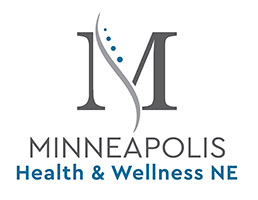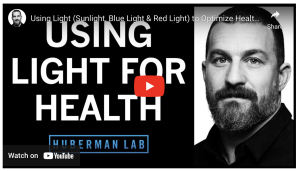Though “red light therapy” often is used to describe light therapy using just one visible red light frequency, for us the term “red light therapy” refers to the combination of visible red light at 633nm and 3) invisible near-infrared (NIR) frequencies from 810 to 940nm that penetrate deeper into the skin. Our commercial light therapy bed also provides other light colors and frequencies to broaden the range of conditions that can be addressed.

LED Light Therapy: Non-Invasive, Medication-Free Solution for Pain Relief, Healing, Skin Improvements, and More
Why Light Therapy?
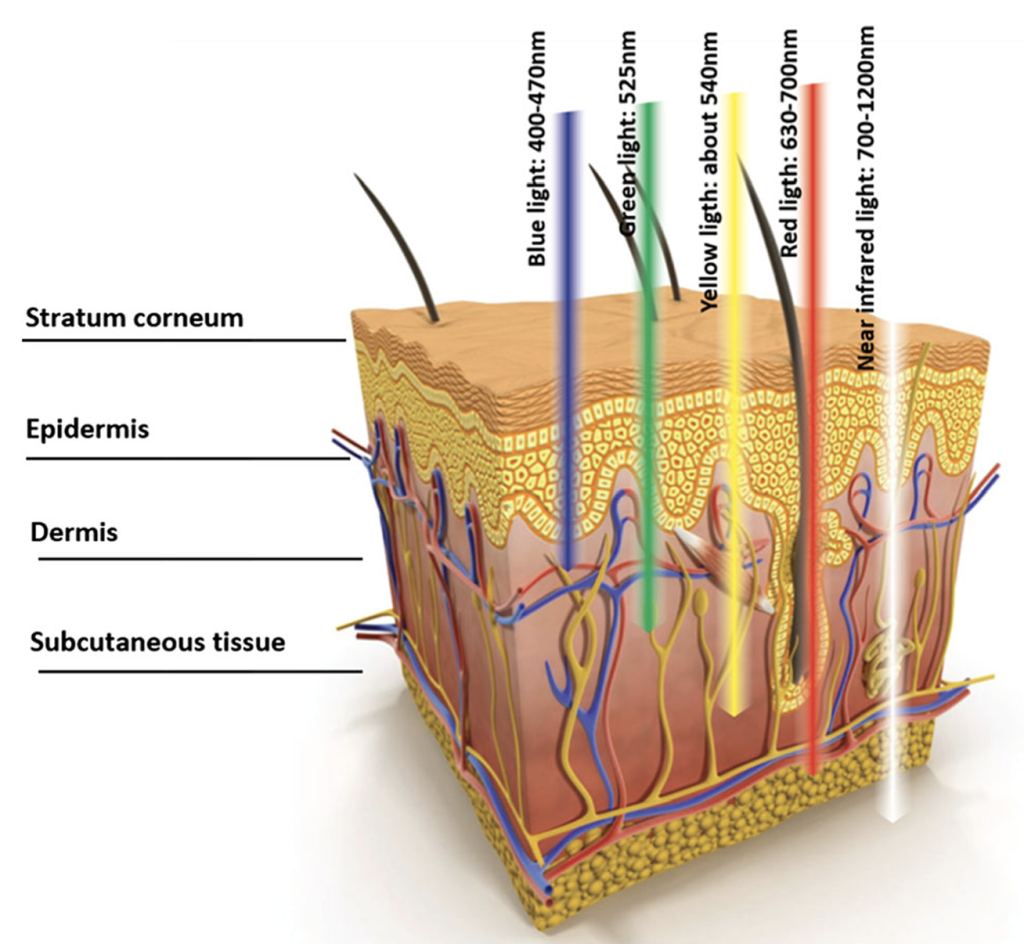 Both the presence of light and the absence of light is critically important for humans. On the positive side, the use of light for health benefits has been known since ancient times, but research and applications have rapidly expanded in the last 2 decades. Much has been studied already on specific wavelengths of both visible and invisible light. We’ve all heard about limiting smartphone and computer use just before bed because blue light, like daylight, tends to energize us. For most of us who live in Minnesota, the absence of light during the dark days of winter can create symptoms associated with seasonal affective disorder (SAD). Another well-known result of a lack of sunlight is our body’s inability to synthesize vitamin D.
Both the presence of light and the absence of light is critically important for humans. On the positive side, the use of light for health benefits has been known since ancient times, but research and applications have rapidly expanded in the last 2 decades. Much has been studied already on specific wavelengths of both visible and invisible light. We’ve all heard about limiting smartphone and computer use just before bed because blue light, like daylight, tends to energize us. For most of us who live in Minnesota, the absence of light during the dark days of winter can create symptoms associated with seasonal affective disorder (SAD). Another well-known result of a lack of sunlight is our body’s inability to synthesize vitamin D.
Studying the impact of different light frequencies on the body is called Photobiomodulation (PBM). PBM Therapy works to use light (LASERS, LEDs, and broadband light, in both the visible and near infrared spectrum) to improve healing, pain, skin health, performance, sleep, and many other conditions. One color of light at one frequency is not the answer. Different colors of light reach their corresponding depths inside the human body, where they create biological responses.
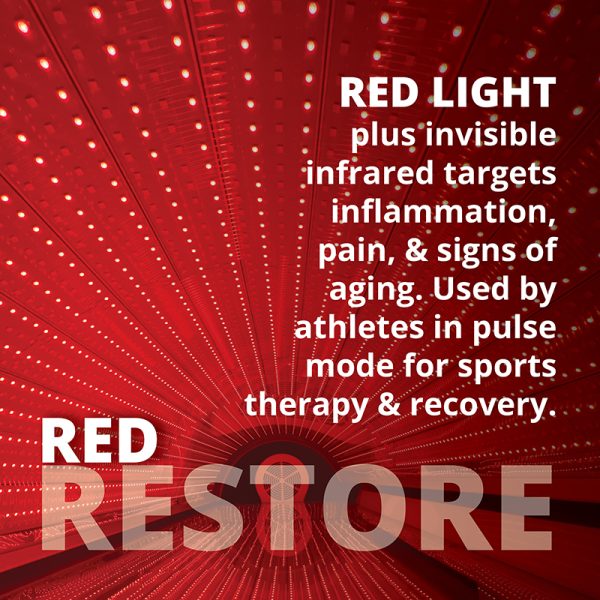
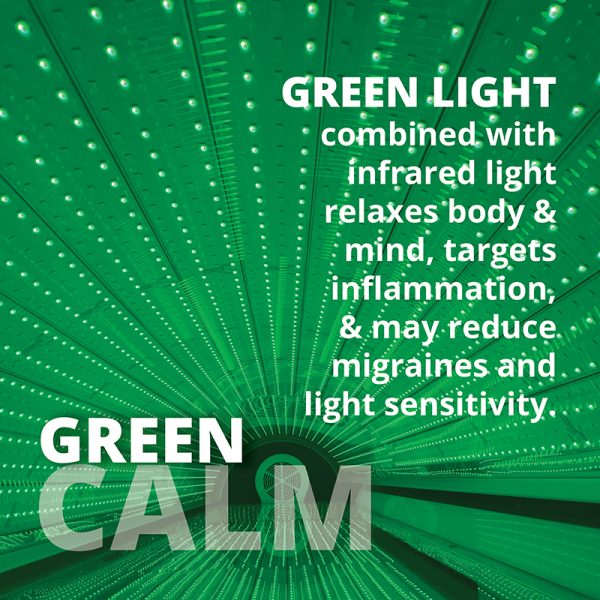
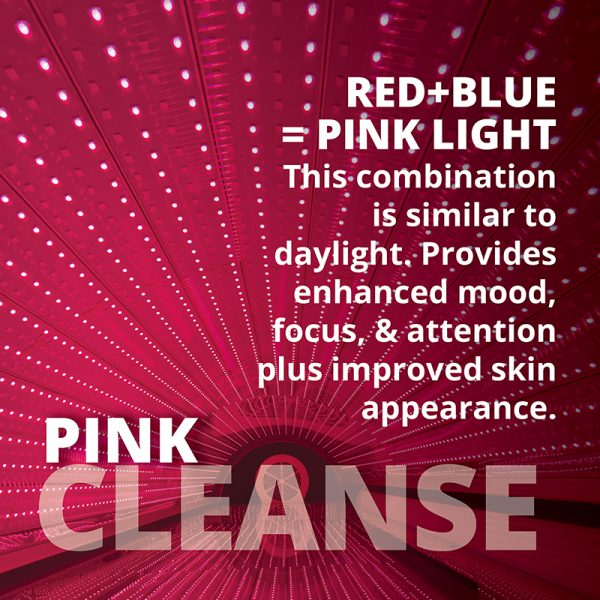
What is Photobiomodulation?
Photobiomodulation (PBM) is a type of light therapy that is often referred to as Low Level Laser Therapy (LLLT). PBM uses specific wavelengths of light to create certain metabolic, neurological, and other physiological effects within the body. This is accomplished by the light being absorbed in subcellular structures of the body, with subsequent bio-chemical reactions affecting the energy production within the cells. The light energy is converted into cellular energy in the form of adenosine triphosphate (ATP), which in turn stimulates the production of more enzymes, improving overall cell function. The therapeutic effect is therefore achieved when the healing light energy is used to interact with the body on a microscopic level, triggering physiological processes to reduce inflammation and facilitate healing.
Every cell of the body is impacted by light therapy: nervous tissue, muscle tissue, connective tissue, and epithelial tissue (like skin.) Thus, people who seek PBM for joint pain and inflammation, are often positively surprised about skin improvements and weight loss.
Who uses Light Therapy?
Short answer: lots of people. Longer answer: PBMT is used by nearly every medical specialty. This includes:
Sports Teams: PBMT is considered to be a drug-free pain management tool for professional sports teams, Olympic teams and other elite athletes. By using PBMT as part of the therapy, many sports trainers have found they can help athletes recover faster. As is often the case, weekend athletes have discovered that PBMT helps heal their common sports injuries and sprains.
Aestheticians and Dermatologists: PBM has been proven effective to speed wound healing, reduce edema, destroy harmful skin bacteria, combat the signs of aging, and improve hair growth.
Dentistry: Photobiomodulation and Low Level Laser Therapy is used in dentistry for a wide range of conditions included treatment/healing of ulcers, reduction of edema, management of inflammatory conditions, and pain reduction.
What are the main reasons people want light therapy?
-
Reduce Pain
-
Control Inflammation
-
Help Heal Wounds
-
Sports Performance & Recovery
-
Improve Skin/Restore Youthfulness
-
Improve Sleep
-
Calm Migraines
-
Lose Weight
You have questions? We have answers.
What is Red Light Therapy?
Red light therapy (aka Photobiomodulation or LLLT) is a treatment that stimulates the body’s cellular processes. We use red and full-spectrum near-infrared light to activate a variety of biological processes.
What is it used for?
Red light therapy is used for and approved to to treat injuries, reduce pain, relax muscles/joints, and increase blood circulation. These are the main applications recognized in the United States by the FDA. Much new research has surfaced over the past decade which suggests many more applications including skin rejuvenation, hair loss prevention, and sleep optimization.
What time of day is best?
Technically any time of day is fine, as you are wearing “black out” goggles. However, there is likely brief exposure to the bright lights. Some lights are calming while others are stimulating. With our light bed, we recommend doing the Restore, Pulse, and Calm Mode any time of day. Cleanse mode however, which contains blue light, should be done in the morning or afternoon only, and not in the late evening. This is because Blue Light is stimulating and thought to enhance mood, focus and attention – is not desired in the evening.
What does blue light do?
As mentioned in the previous paragraph, Blue Light is stimulating and thought to enhance mood, focus and attention. Blue light is part of the spectrum of light we get from daylight, and it is also associated with cleansing and disinfecting. Research suggests that the combination of red and blue light may reduce bacteria-caused blemishes on the skin resulting in an overall improved appearance of the skin. The downside of blue light is that even small amounts of if in the evening may suppress the release of melatonin, and thereby throw off the circadian rhythm. Thus, those sensitive to it may have a harder time to sleep at night.
What does green light do?
We offer a unique Green and Infrared light mode, namely the “Calm Mode”. Green light has the most calming effect on the mind among all colors in the visible light spectrum. A Harvard study suggests that exposure to green light may reduce migraines. While blue and red light may have an activating effect on the body while green light achieves the opposite. Combined with our bed’s invisible and deeply penetrating and muscle relaxing infrared light frequencies the calm mode was born. Beyond its calming effect, Green Light may also improve the appearance of dilated capillaries, sagging skin around the eyes, under eye circles, hyperpigmentation and sun spots. Research suggests that deep penetrating near-infrared light energy may reduce the appearance of hyperpigmentation by down-regulating hyperactive melanocytes in the dermis. Other studies suggest that Green Light may prevent the production of excess melanin, resulting in less pigmentation on the skin’s surface, resulting in a brighter, more even skin tone.
How often CAN I do this? How often SHOULD I do this?
You could use light therapy every day if you wanted. It’s not harmful. But daily use isn’t practical for most of us. Even though it’s only an 8-minute treatment, most of us don’t have that kind of flexibility in our schedules.
Every person is different and your needs may vary. We’ll make a recommendation based on your concerns, your desired outcome, and your schedule. This is a general guideline:
For many people seeking relief from chronic pain, a starting point is around 3 – 5 treatments per week for about a month. People often see improvement after a week, but continuing treatments over a sustained period will yield better results. Consistency is key to reach results.
For active people, many will use light therapy like professional athletes and athletic teams do: before a big event, to bump up athletic performance goals, or to recover after a strenuous workout. You will find LED Light Therapy beds like ours in nearly every professional sports training facility. It’s a very common, well-known part of therapy and recovery. (Often athletes use red light therapy in pulse mode for improved results.)
For immediate relief from headaches, joint pain, inflammation, muscle strain, skin breakout, and similar, same-day appointments are often available. You can also schedule further appointments to keep your recovery on track.
Is this only for athletes and athletic-type people?
Not at all. While there is much talk about strength, endurance, and recovery time, photobiomodulation improves cellular processes resulting in a number of benefits (see above) for any adult. Light therapy is for all of us who want to do more, feel better, and look younger.
Why are you using a full 360° bed and not single panels?
Red light panels are an inexpensive way to use red light therapy at home, and there are some good options available today. In fact, the company that makes our bed is working on creating high-powered panels for home use to make our technology available to more people. Having said that, panels have multiple drawbacks compared to a full bed.
First is power: Panels offer a much lower dose than a high-powered light bed, meaning you need far more exposure time plus you are standing throughout the process. Because the user is standing, distance to the body becomes the next problem.
Second, distance: The power of a light wave drops exponentially with distance. This means if you are 3 inches away from the light source vs 10 inches (or even 1 – 2 ft as we often see with light panels) the actual dose can be reduced to almost nothing. While light panels are aesthetically pleasing in social media posts, the actual benefits of many of the existing products are questionable. With our bed the user is only about 2 – 3 inches from the LEDs in the base of the light bed, and only up to 5 inches from those in the canopy. You are fully engulfed in light from up to 36,360 high powered LEDs, an exposure that simply can not be matched with a simple light panel. The illustration below shows the distance between the user and the LEDs, which is far closer than most of our competitors.
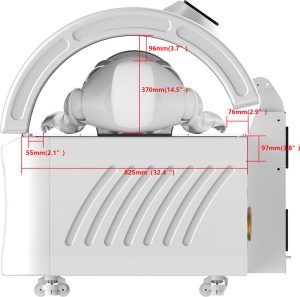
What's the difference between this light bed and an Infrared Sauna?
While both modalities use the term “infrared”, they are completely different mechanisms. An infrared sauna uses light to make heat. It typically uses FAR-Infrared heat to stimulate sweat glands for detoxification, so they are extremely warm if not hot. Red Light Therapy uses light which penetrates the body deep into the cell. It is often referred to as Low Level Laser Therapy or Cold Laser Therapy, thus heat is not involved. The goal is to improve cellular function and allow the cell to produce ATP. Our bed uses a combination of red light and NEAR-infrared cold light to reverse oxidative stress, reduce pain, inflammation and improve cellular energy production.
How long does each treatment take?
Our professional LED Light Therapy bed is designed to make treatments really efficient. One light therapy treatment is just 8 minutes.
Are there people who should not use light therapy?
YES! These people should NOT use our light therapy bed:
- Pregnant women, customers with cardiac pacemakers, and patients with malignant tumors.
- Customers who are allergic to light therapy or who take photosensitizers (such as chlorpromazine).
- Customers with active hemorrhage or shock, and internal organ damage.
- Customers with high fever, active tuberculosis, vasculitis obliterans, etc.
- Patients with severe heart and kidney disease, such as heart failure, myocarditis, uremia, etc.
- Patients with skin diseases should use it under the guidance of a doctor.
Does the bed get hot?
No, not at all. The lights don’t create heat like infrared or a tanning bed.
Do I need to be undressed?
The light does in fact need to hit your skin directly. You can undress to a level that’s comfortable for you. The only thing you must wear are black-out goggles which we provide.
Is it complicated to set up and use?
No! One of the reasons we decided to install this particular bed is that it provides one-button control. It’s SO easy!

Need more info?
If you’re interested in reading about light therapy, there is a volume of research from many reputable sources. This is a great place to start.
Dr. Andrew Huberman. a professor of neurobiology and ophthalmology at Stanford School of Medicine, describes how different wavelengths of light impact the cells. While the professional bed we use is not mentioned, we have found it valuable for people who want to learn more about the benefits of light therapy.
Click to visit the Huberman Lab
“I describe the mechanisms by which different wavelengths of light impact the cells, tissues, and organs of the human body, and how specifically timed light exposure of specific wavelengths can be used to improve sleep, enhance alertness, modulate hormone levels, and improve mood. I also explain the use of ultraviolet and infrared phototherapies to relieve pain increase testosterone and estrogen levels; improve skin health, appearance, and wound healing; and how red light can be used to offset age-related vision loss and provide neuroprotection. Throughout the episode, I describe the mechanisms of light-based therapies and actionable tools that people can use positively impact mental and physical health.” –Dr. Andrew Huberman
You can access a wide range of professional papers and studies here.
Aches and pains
https://pubmed.ncbi.nlm.nih.gov/12775206/
Skin stimulating, healing and restoring
Red light and mitochondrial function (ATP)
https://www.nature.com/articles/s41598-021-02311-1#citeas
Oxidative stress and mitochondrial function
https://pubmed.ncbi.nlm.nih.gov/16120414/
Exposure to green light may alleviate migraines and other chronic pain
https://www.tmc.edu/news/2020/02/exposure-to-green-light-may-reduce-pain/
Green Light for Migraine Relief
https://hms.harvard.edu/news/green-light-migraine-relief
Green light and longevity
https://pubmed.ncbi.nlm.nih.gov/33539986/
Blue light and Acne
https://pubmed.ncbi.nlm.nih.gov/16249142/
Blue + Red for mild to severe acne:
https://www.defelipe.com/wp-content/uploads/2020/11/Acne-Goldberg.pdf
Combination blue (415 nm) and red (633 nm) LED phototherapy in the treatment of mild to severe acne vulgaris
https://pubmed.ncbi.nlm.nih.gov/16766484/
Phototherapy with blue (415 nm) and red (660 nm) light in the treatment of acne vulgaris
https://pubmed.ncbi.nlm.nih.gov/10809858/
Effect of Blue Light on Acne Vulgaris: A Systematic Review
LightBed Pricing:
INDIVIDUAL SESSIONS
Discovery Session: $10
1-Time Intro Package: 5 for $75
Time of Service Appt. $37.60
PACKAGES
5 Pack: $150.00
8 Pack: $200.00
12 Pack: $240.00
24 Pack: $408.00
UNLIMITED MEMBERSHIPS
Unlimited for 1month: $500 per month
Unlimited for 3 months: $300 per month
Unlimited for 6 months: $250 per month
Unlimited for 12 months: $200 per month
For all PMBT Unlimited Memberships: 2 sessions per day maximum (health guidelines)
To buy packages, please call us: 612-750-7168
